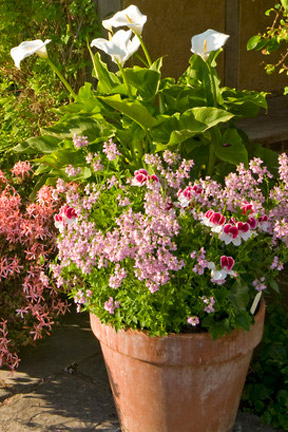Container & Pot Plant Care - Late Summer
 It’s the time of year when containers and pots with bedding plants start to look a little bit sad. Some of the plants are coming to the end of their flowering, and some are dying back, but others are still flowering. What should you do to keep them looking good for as long as possible? Here are some useful pointers that should help you keep your display going for a bit longer.
It’s the time of year when containers and pots with bedding plants start to look a little bit sad. Some of the plants are coming to the end of their flowering, and some are dying back, but others are still flowering. What should you do to keep them looking good for as long as possible? Here are some useful pointers that should help you keep your display going for a bit longer.
1) Clear out the old
The best thing to do with those plants that have finished flowering and died back, such as Lobelia, is to pull them out lock, stock and barrel. Yes, it will leave spaces, but better spaces than dead plants. So have a good clear out of the pots. And while you’re at it, deadhead everything else. As long as the sun keeps shining, deadheaded plants will generally keep flowering.
2) Topdress and feed
No wonder your poor plants are looking a bit sad, they’ve been living in the same compost since May! And it’s only supposed to feed for a month. So when you’ve tidied up a bit, and you can see the soil again, give the plants a feed with a good general purpose soluble plant food and also top dress with any leftover compost. Alternatively, give them a treat, and buy compost specially for the job.
3) Fill in the gaps
Garden centres often have later flowering plants in stock in late summer and early autumn, so go and grab yourself some showy autumn colour, such as asters, chrysanthemums or dahlias to fill the gaps left by removing the dead plants. Many of these plants are perennials, and can be transplanted to the garden once you’ve finished with them in pots, so don’t worry about spending money for a very short-lived effect. These are likely to give you autumn colour for several years.
4) Routine maintenance
This is just as important now as it was earlier in the year. Keep deadheading, it’s not just a one-off process. If you have geraniums, you’ll also need to keep removing dead leaves to keep them looking good. And do keep watering. Even if it seems to be raining fairly regularly, your plants are now mature, and need plenty of water, which they may not be able to get from the soil in the container. So keep your watering system switched on, or carry on doing the rounds with your watering can or hose every couple of days.
If you keep these ideas in mind, you should find that your containers reward you with at least a few more weeks, and possible months, of flowering, well into autumn, when you want to plant up your spring bulbs.